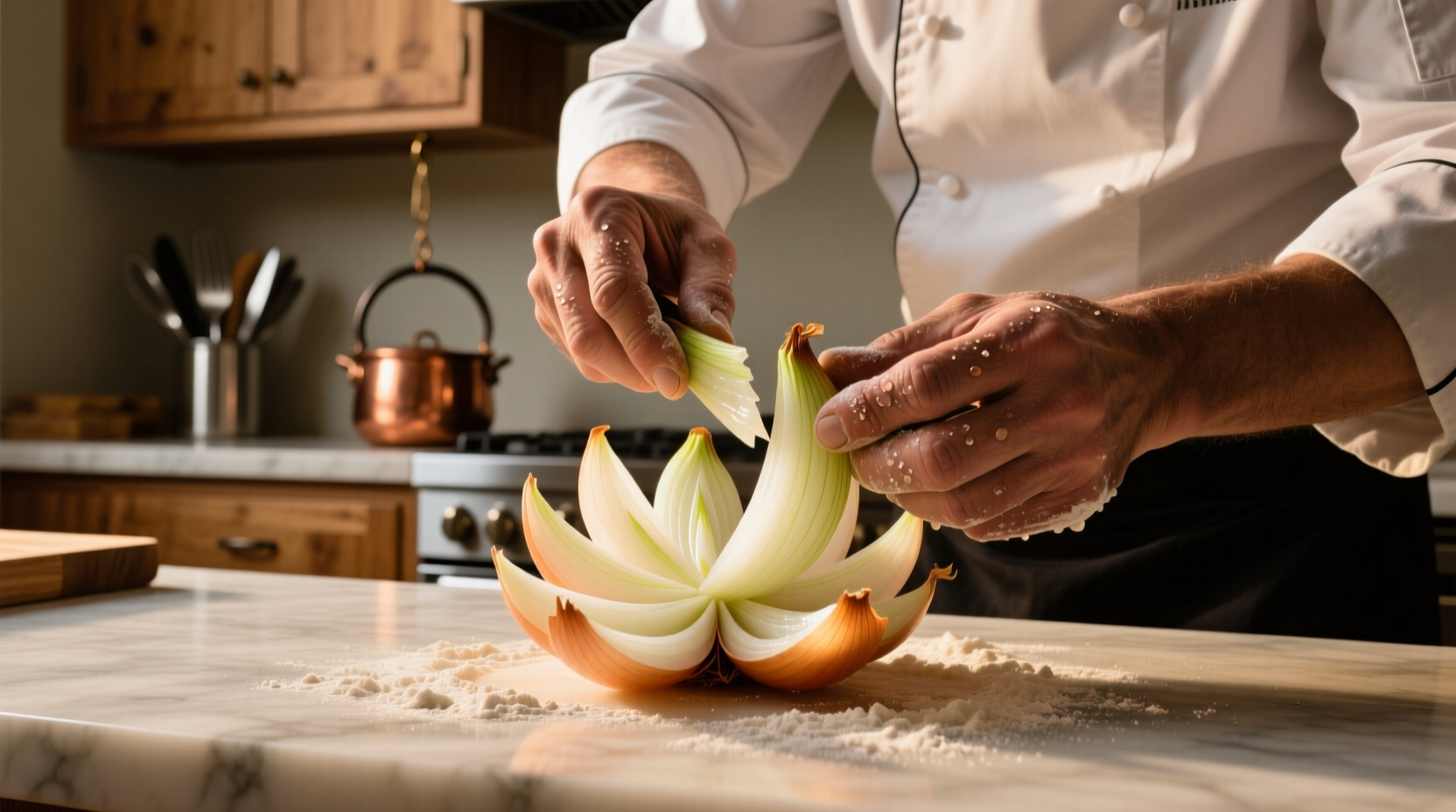Ever wondered why recipes sometimes mention "onion petals" when preparing dishes like blooming onions or fancy garnishes? You're not alone. Many home cooks mistakenly believe onions have petals like flowers, but the truth reveals a fascinating intersection of botany and culinary technique that can transform your cooking.
Why Onions Don't Have Petals (And What They Actually Have)
Botanically speaking, onions (Allium cepa) are modified leaves that form concentric layers around a central bud. Unlike flowers that have petals as reproductive structures, onions develop these layered scales for energy storage. The confusion likely stems from culinary terminology where chefs describe separated onion layers as "petals" when creating decorative presentations.
| Botanical Feature | Onion Structure | Flower Structure |
|---|---|---|
| Primary Function | Energy storage | Reproduction |
| Composition | Modified leaves (scales) | Petals (modified leaves) |
| Arrangement | Concentric layers | Radial pattern around center |
| Culinary Term | "Onion petals" (misnomer) | Actual petals |
The Culinary Evolution: How "Onion Petals" Entered Kitchen Vernacular
The term "onion petals" gained traction in professional kitchens during the 1990s restaurant boom, particularly with the popularity of blooming onions. According to culinary historians at the Culinary Institute of America, chefs adopted floral terminology to describe the visual effect of fanned onion layers that resemble flower petals.
1980s: Early references to "onion flowers" in Southern U.S. cooking
1993: Outback Steakhouse popularizes "Bloomin' Onion" with layered presentation
2000s: Cooking shows and food media adopt "onion petals" terminology
Present: Term persists despite botanical inaccuracy
Practical Applications: Working With Onion Layers Like a Pro
Understanding this distinction isn't just academic—it directly impacts your cooking results. When recipes call for "onion petals," they're actually referring to carefully separated layers used for specific techniques:
Perfecting the Onion Bloom Technique
For that restaurant-style blooming onion effect:
- Choose large, firm yellow onions with tight layers
- Cut root end but leave intact to hold layers together
- Make precise vertical cuts 1/4 inch apart through the bulb
- Soak in ice water for 30 minutes to encourage "blooming"
- Separate layers gently without tearing
Culinary Uses for Individual Onion Layers
Professional chefs utilize separated onion layers in several applications:
- Decorative garnishes: For soups, salads, and plated dishes
- Individual cooking vessels: Filled with mixtures for appetizers
- Even cooking: Separating layers ensures uniform caramelization
- Texture contrast: Using outer vs. inner layers for different applications

Avoiding Common Onion Layer Mistakes
Many home cooks struggle with working with individual onion layers. Here's what to watch for:
When Separation Becomes Destructive
While some recipes benefit from separated layers, certain cooking methods actually require intact structure:
- Roasting whole onions: Separating layers causes disintegration
- Caramelizing: Too much separation creates uneven cooking
- Pickling: Loose layers absorb brine unevenly
Preserving Onion Integrity During Separation
Follow these professional tips for clean layer separation:
- Chill onions for 30 minutes before handling for firmer layers
- Use a paring knife to gently loosen the first few layers
- Work from the outside in, not the center out
- Handle layers by their thicker edges to prevent tearing
- Work over a bowl to catch juices and minimize waste
Maximizing Flavor Through Proper Layer Selection
Not all onion layers are created equal. Each layer offers distinct flavor profiles that professional chefs leverage:
| Layer Position | Flavor Profile | Best Culinary Uses |
|---|---|---|
| Outer 2-3 layers | Strongest, most pungent | Stocks, soups, long-cooked dishes |
| Middle layers | Balanced sweetness and bite | Sautéing, stir-fries, general cooking |
| Inner layers | Mildest, sweetest flavor | Raw applications, salads, garnishes |
| Core/bud | Most concentrated flavor | Flavor base for sauces, discard if bitter |
According to research from the USDA Agricultural Research Service, the outer layers contain higher concentrations of protective compounds that contribute to their stronger flavor, while inner layers develop more sweetness as the onion matures.
Storage and Preparation Tips for Optimal Results
Proper handling makes all the difference when working with onion layers:
- Store whole onions in cool, dark, well-ventilated spaces (not refrigerated)
- Once separated, store layers in airtight containers for up to 3 days
- Prevent browning by dipping cut surfaces in lemon water
- For best separation results, use onions within 2 weeks of purchase
- Avoid plastic bags for storage—they accelerate spoilage
Understanding the distinction between actual petals and onion layers transforms how you approach recipes calling for "onion petals." This knowledge helps you select the right onion variety, prepare it properly, and achieve professional results at home. Whether you're creating an impressive blooming onion appetizer or simply wanting evenly cooked vegetables, respecting the onion's natural structure leads to better culinary outcomes.











 浙公网安备
33010002000092号
浙公网安备
33010002000092号 浙B2-20120091-4
浙B2-20120091-4